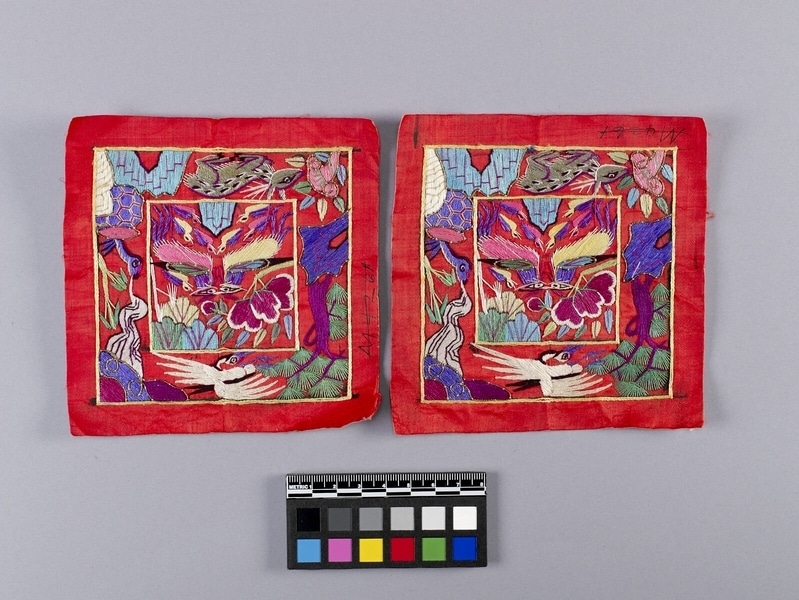Pillow End Panel Item Number: N3.4 a-b from the MOA: University of British Columbia

Description
Two virtually identical square pillow end panels (parts a-b) embroidered on red fabric pasted to paper. Each has images in an inner square framed in yellow thread which is surrounded by images also framed in yellow thread. The images on the inner square consist of a pair of birds facing each other with long tail feathers, one with a pink body and the other with a yellow body. Below them are six baby birds with a seventh on the back of the pink bird. There is a green triangular shape between them and flowers with leaves above. Images in the outer rectangle include a white flying crane at the top, a pine tree on the right below which is a purple rock shape, below which, there is a mushroom shape with green leaves. At the centre bottom, there is a kneeling grey deer, behind which, there is a blue-green rock shape. Above that, facing upwards, there is a tortoise with a white wavy shape coming from its mouth, beside which, there is a stalk of bamboo.
History Of Use
Such panels formed the sides of high pillows, square or rounded in cross-section, used to keep cool and to preserve the user’s hairdo. The pillows were filled with grain, such as unhusked rice. Such special pillow ends were used by wealthy people and members of the official (yangban) class. The work was done by women working in workshops. Small, red panels were probably for the pillow end panels of brides, who included such pillows in their dowries. They were made for the bride by her mother, her godmother, or a female servant.
Specific Techniques
The cloth was dyed with natural dye. The embroidery pattern was drawn onto the silk using Korean ink. The embroidery was done with the silk cloth stretched on a rectangular frame, using satin stitch and couching. The finished piece was pasted onto paper to make it stiff.
Iconographic Meaning
The images are ten symbols of long life. The pair of birds with baby birds symbolizes fidelity and fertility. The yellow outlines indicate that these are for the use of the official “yangban” class; gold would be used for members of the court.
Item History
- Made in Korea before 1939
- Collected between 1899 and 1939
- Owned by Marion Stephan before August 1964
- Received from Marion Stephan (Donor) during August 1964
What
- Name
- Pillow End Panel
- Identification Number
- N3.4 a-b
- Type of Item
- panel
- Material
- silk fibre, gold metal, paper, dye and paste adhesive
- Manufacturing Technique
- woven, dyed, drawn, embroidered, couched and pasted
- Overall
- height 13.1 cm, width 12.9 cm, depth 0.2 cm
Who
- Culture
- Korean
- Previous Owner
- Marion Stephan
- Received from
- Marion Stephan (Donor)
Where
- Holding Institution
- MOA: University of British Columbia
- Made in
- Korea
When
- Creation Date
- before 1939
- Collection Date
- between 1899 and 1939
- Ownership Date
- before August 1964
- Acquisition Date
- during August 1964
Other
- Item Classes
- textiles
- Condition
- good
- Accession Number
- 0113/0057 j a-b